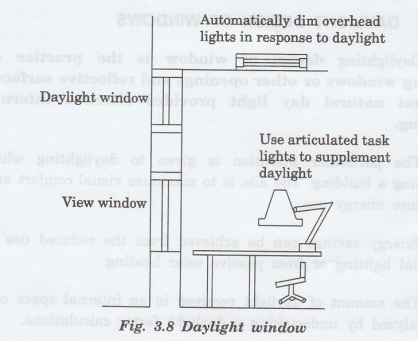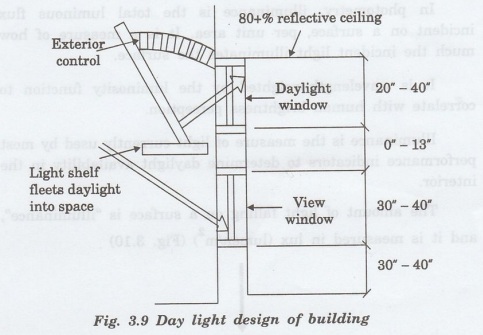Physics For Civil Engineering: Unit III: Acoustics and Lighting Designs
Daylight Design of Building Windows
Daylighting design of window is the practice of placing windows or other openings and reflective surfaces so that natural day light provides effective internal lighting.
DAYLIGHT DESIGN OF WINDOWS
Daylighting design of window is the practice of
placing windows or other openings and reflective surfaces so that natural day
light provides effective internal lighting.
The
particular attention is given to daylighting while designing a building. The
aim is to maximize visual comfort and to reduce energy use.
Energy
savings can be achieved from the reduced use of artificial lighting or from
passive solar heating.
The
amount of daylight received in an internal space can be analyzed by undertaking
a daylight factor calculations.
Windows
•
Window is used for allowing light, heat and sound.
• Double layered window is used to
reduce noise, heat, cold and other environmental factors.
If window height is increased from
floor, light entering the building will be reduced. Further, the ceiling from
the floor should be at a height of 2.5 m-3 m for better lighting.
Windows
on multiple orientations are combined to produce the right mix of light for the
building for different climate and latitude.
Preferred
Window - Wall Ratios (WWR)
For view and a positive connection out
of doors, a minimum 20 percent to 30 percent ratio of window area in wall area
is prefered.
Glazing
the wall areas below desk height (0-30 inch above the floor) benefits for day
light (Fig.3.8)

High windows
High
continuous windows are more effective than individual or vertical windows, to
distribute light deeper into the space.
The
top of windows should be close to ceiling line (for day lighting). The bottom
of windows should not be higher than 48 inches (for view).
The
windows must be separated into two horizontal strips. One strip can be placed
at eye level for view, and another strip to maximize daylight penetration.
High
ceilings
More
daylight savings are realized if ceiling heights are 10 feet or higher. Greater
daylight harvesting can be achieved by increasing ceiling heights to 11 feet or
higher.
Light
Shelves
The
light shelves (interior or exterior) can be used between daylight window and
view window
These
are effective for achieving greater uniforming of day lighting. Further, it
extends ambient levels of light onto the ceiling and deeper into the space.
Window
and office placement
Daylighting
is more cost effective if open plan workstations are located on the north and
south side of the building. The open plan areas are more continuously occupied
and achieve lower savings.
The
open configuration also absorbs less light. The inter- reflections provide a
more uniform distribution of light deep into the space. (Fig. 3.9)

Interior sun control
Similar to exterior sun control,
horizontal blinds on the south windows and vertical blinds on the east and west
are most effective. nwode
Vertical blinds that retract fully for
the middle of the day are recommended for these conditions. Perforated blinds
and translucent shades may cause glare when hit by direct sunlight.
Physics For Civil Engineering: Unit III: Acoustics and Lighting Designs : Tag: : - Daylight Design of Building Windows
Related Topics
Related Subjects
Physics for Civil Engineering
PH3201 2021 Regulation | 2nd Semester Civil Dept 2021 Regulation
